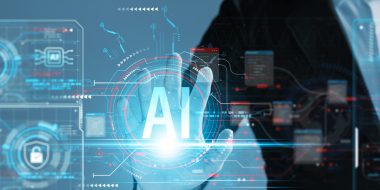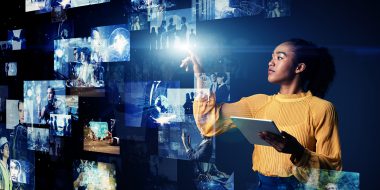Generative AI is a rapidly evolving disruptive technology that has turned into a buzzword across multiple industries with endless possibilities to transform every aspect of their business. As per a research and consulting firm, by 2025, around 30% of outbound marketing messages from large organizations will be synthetically generated using generative AI applications. The technology combines unsupervised and semi-supervised algorithms. It allows computers to detect the underlying pattern and create new content using previously created content, including code, video, audio, text, and images.
Currently, generative AI uses two well-known models: generative adversarial networks (GAN) and a transformer-based model known as generative pre-trained transformer (GPT). The GAN is used to generate visual and multimedia content using two neural networks from text and imagery data, while GPTs are autoregressive language models trained to understand the image or language, learn classification tasks, and create texts and images from huge datasets. According to Sequoia Capital, a well-known capital firm, “Generative AI has the potential to generate trillions of dollars in economic value” in the coming future.
Adoption of generative AI by market pioneers
In recent years, the market has seen the inclination of major generative AI technology providers. Github, a subsidiary of Microsoft, launched a service called CodeAssist to assist programmers by recommending software snippets that might help fill a gap. IBM has started using generative AI models for drug research and design. Through its web services, Amazon introduced Polly, a tool for turning text into speech, and DeepComposer, a programme that can transform a short melody into a complete song.
Related reading : Revolutionizing big tech with AI-as-a-Service : a deep dive into the benefits
Top applications of generative AI in 2023
- Image generation – It is the transformation of text into images and generation of realistic images based on a user-specified subject, style, setting, or location. Generative AI is also applied in face synthesis and voice cloning in movie production and restoration. It has commercial applications in media and entertainment, marketing, advertisement, gaming, education, and other related fields. For example, DALL-E by OpenAI is an AI-based image generator used in the advertising sector. Here, Heinz, a food processing company, used an image of a ketchup bottle with a label resembling its own to declare, “This is what ‘ketchup’ looks like to AI”. Using AI DALL-E, Nestle also used an AI-enhanced version of a Vermeer painting in order to market and sell one of its yogurt brands.
- Communication and conversational applications – Currently, large language models (LLMs) are used in conversational AI and chatbots due to their ability to generate text which is more fluent and coherent compared to earlier language models. For example, Google LaMDA, a conversation technology developed for dialog and conversations. It can differentiate open-ended conversation from other forms of language. Similarly, Meta’s BlenderBot is designed to maintain context across lengthy conversations. It can scan the entire internet for chats on virtually any topic and is designed to learn how to improve its skills through natural conversations and feedback from humans.
- Space synthesis – Generative AI can also be used to create real as well as digital 3D spaces and objects, from building designs to entire city plans and virtual spaces for gameplay. For example, Meta is developing BuilderBot which will focus on virtual spaces and Spacemaker, a cloud-based AI architectural program or software used in designing real estate sites.
- AI in healthcare – The healthcare sector is adopting generative AI to create patient-level simulated records using publicly available data and to generate new data sets that are beyond human capabilities. With the help of a GAN, x-rays and CT scans can be converted to photo-realistic images by sketches-to-photo translation. For example, Syntegra uses generative AI technology to learn from any structured data including electronic health records (EHR), registries, claims, and clinical trials, and create simulated patient records.
- Video generation – Videos are a collection of moving visual images created in a manner similar to that of still images. Generative AI technology helps in video frame prediction. It can predict what the next frame in the sequence would look like and generate it. For Example, NVIDIA’s deep learning supersampling (DLSS) is a neural graphics technology used to reconstruct images. The image reconstruction feature of its AI network analyses sequential frames and motion data to create new frames with a higher resolution.
- Audio generation – Generative AI is used in the production of realistic speech audio and in voice generation using existing voice sources. Additionally, it is applied in music production through music-generation tools. For example, tech giants such as Apple acquired AI Music, to bulk up its audio technology. AI Music is a start-up that applies artificial intelligence to generate tailor-made music. It can generate dynamic soundtracks using artificial intelligence and royalty-free music, where the music used in the video games will react to the user’s mood or during workout the music could be adjusted automatically as per the user’s intensity.
Benefits of generative AI
- Improved identity protection – It helps in the creation of Avatars, to protect the identity of the people who do not want to disclose their identities while interviewing or working online.
- Fraud detection – Generative AI-enabled tools can detect malicious, illegal, and suspicious activities performed by hackers and protects the business or an individual.
- Speedy product delivery – The technology helps speedup digital product delivery and improves operational efficiency.
- Disease detection – In the field of healthcare, GAN can be applied in the early-stage detection of brain tumors and in drug discovery by reducing cost and time.
- Enhanced reinforcement machine learning – Generative AI reinforces devices with machine learning models that are less at bias.
However, there are certain challenges that can be encountered in generative AI-based technology. Applications powered with generative AI, used in healthcare and defense sectors that depend on data may face privacy concerns. The technology can also be used for fraudulent activities, including scamming, and spreading fake news. For example, a fake video of the Ukrainian President pleading with the people to surrender recently surfaced. It was broadcasted on hacked Ukrainian news outlets.
Start-up companies in the domain
At present, there are several companies competing in the generative AI market, of which numerous start-ups have entered the domain. Generative AI tech is used across multiple industries, including retail, healthcare, media, marketing, finance, gaming, educational, entertainment, and many more. Some of such companies are mentioned below under different categories.
Recent investment trends
During this year several investments have been made in the field of generative AI. Start-ups touching various aspects of generative AI technology are getting tremendous funding by all kinds of investors. As per a capital market firm’s data, venture capital investment in generative AI has increased 425% since 2020.
Concluding thoughts
Generative AI is creating its space and presence among numerous tech companies and start-ups. It improves people’s imagination and creativity, and as technology advances, more advanced applications will be explored. With the advancement of AI technology, businesses, governments, consumers, and non-profit organizations will have great opportunities in their fields as it allows people to be more innovative, creative, and imaginative in achieving their business goals. Companies in the market are actively using generative AI to explore new opportunities in their businesses by leveraging the technology’s broad capabilities. By 2027, around 30% of manufacturers will start using generative AI in their production process to enhance their product development efficiency.
With benefits comes challenges, and to overcome such challenges, the regulating authorities should focus more upon strengthening their regulatory standards and imposing fines while keeping track of generative AI-related data.
In conclusion, generative AI has already demonstrated its vast potential in a wide range of fields, from creative industries to healthcare and finance. As this technology continues to evolve and become more sophisticated, it is likely that we will see even more innovative and impactful applications in the future. Gain insights into technology trends that are currently gaining ground in the markets with Netscribes’ market research solutions. To know more, contact us
Based on insights from Urvashi Sethi, Manager, Research and Information, TMT.






